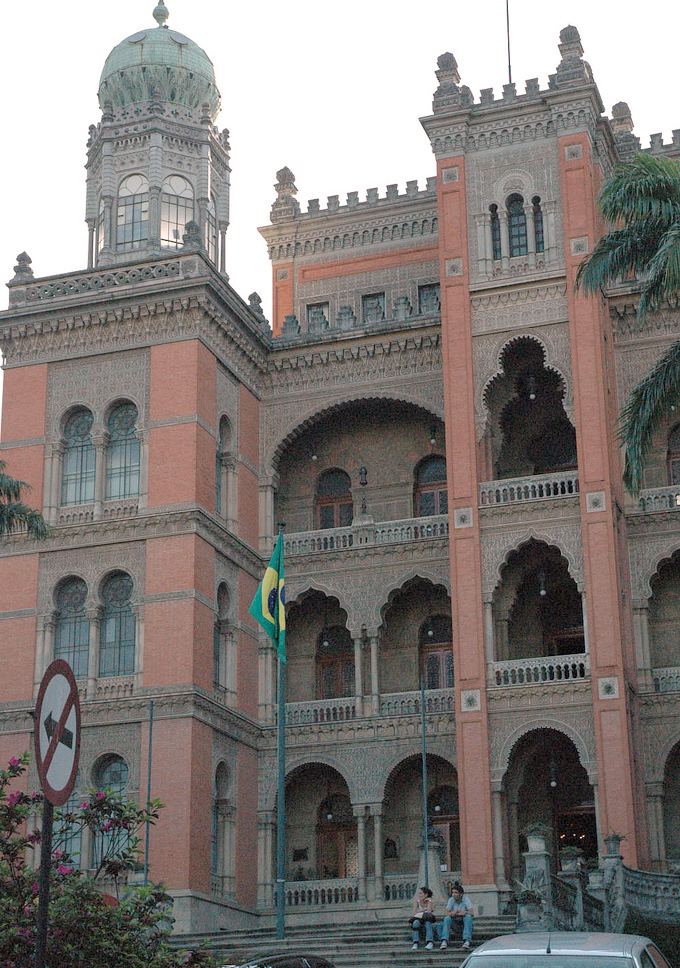 | ||
Moorish Revival or Neo-Moorish is one of the exotic revival architectural styles that were adopted by architects of Europe and the Americas in the wake of the Romanticist fascination with all things oriental. It reached the height of its popularity after the mid-19th century, part of a widening vocabulary of articulated decorative ornament drawn from historical sources beyond familiar classical and Gothic modes.
Contents
In Europe
The "Moorish" garden structures built at Sheringham Hall, Norfolk, ca. 1812, were an unusual touch at the time, a parallel to chinoiserie, as a dream vision of fanciful whimsy, not meant to be taken seriously; however, as early as 1826, Edward Blore used Islamic arches, domes of various size and shapes and other details of Near Eastern Islamic architecture to great effect in his design for Alupka Palace in Crimea, a cultural setting that had already been penetrated by authentic Ottoman styles. By the mid-19th century, the style was adopted by the Jews of Central Europe, who associated Moorish and Mudéjar architectural forms with the golden age of Jewry in medieval Muslim Spain. As a consequence, Moorish Revival spread around the globe as a preferred style of synagogue architecture.
In Spain, the country conceived as the place of origin of Moorish ornamentation, the interest in this sort of architecture fluctuated from province to province. The mainstream was called Neo-Mudéjar. In Catalonia, Antoni Gaudí's profound interest in Mudéjar heritage governed the design of his early works, such as Casa Vicens or Astorga Palace. In Andalusia, the Neo-Mudéjar style gained belated popularity in connection with the Ibero-American Exposition of 1929 and was epitomized by Plaza de España (Seville) and Gran Teatro Falla in Cádiz. In Madrid, the Neo-Mudéjar was a characteristic style of housing and public buildings at the turn of the century, while the 1920s return of interest to the style resulted in such buildings as Las Ventas bullring and Diario ABC office. A Spanish nobleman built the Palazzo Sammezzano, one of Europe's largest and most elaborate Moorish Revival structures, in Tuscany between 1853 and 1889.
Although Carlo Bugatti employed Moorish arcading among the exotic features of his furniture, shown at the 1902 exhibition at Turin, by that time the Moorish Revival was very much on the wane almost everywhere. A notable exceptions were Imperial Russia, where the shell-encrusted Morozov House in Moscow (a stylisation of the Pena National Palace in Sintra), the Neo-Mameluk Dulber palace in Koreiz, and the palace in Likani exemplified the continuing development of the style.
Another exception was Bosnia, where, after its occupation by Austria-Hungary, the new authorities commissioned a range of Neo-Moorish structures. The aim was to promote Bosnian national identity while avoiding its association with either the Ottoman Empire or the growing pan-Slavic movement by creating an "Islamic architecture of European fantasy". This included application of ornamentations and other Moorish design strategies neither of which had much to do with prior architectural direction of indigenous Bosnian architecture. The central post office in Sarajevo, for example, follows distinct formal characteristics of design like clarity of form, symmetry, and proportion while the interior followed the same doctrine. The National and University Library of Bosnia and Herzegovina in Sarajevo is an example of Pseudo Moorish architectural language using decorations and pointed arches while still integrating other formal elements into the design.
In the United States
In the United States, Washington Irving's fanciful travel sketch, Tales of the Alhambra (1832), first brought Moorish Andalusia into readers' imaginations; one of the first neo-Moorish structures was Iranistan, a mansion of P. T. Barnum in Bridgeport, Connecticut. Constructed in 1848 and destroyed by fire ten years later, this architectural extravaganza "sprouted bulbous domes and horseshoe arches". In the 1860s, the style spread across America, with Olana, the painter Frederic Edwin Church's house overlooking the Hudson River, Castle Garden in Jacksonville and Longwood in Natchez, Mississippi usually cited among the more prominent examples. After the American Civil War, Moorish or Turkish smoking rooms achieved some popularity. There were Moorish details in the interiors created for the Henry Osborne Havemeyer residence on Fifth Avenue by Louis Comfort Tiffany. The 1914 Pittock Mansion in Portland, Oregon incorporates Turkish design features, as well as French, English, and Italian ones; the smoking room in particular has notable Moorish revival elements. In 1937, the Corn Palace in Mitchell, South Dakota added unusual minarets and Moorish domes, unusual because the polychrome decorations are made out of corn cobs of various colors assembled like mosaic tiles to create patterns. The 1891 Tampa Bay Hotel, whose minarets and Moorish domes are now the pride of the University of Tampa, was a particularly extravagant example of the style. Other schools with Moorish Revival buildings include Yeshiva University in New York City. George Washington Smith used the style in his design for the 1920s Isham Beach Estate in Santa Barbara, California.
Europe
United States
Latin America
Churches and cathedrals
Shriners Temples
The Shriners, a fraternal organization, often chose a Moorish Revival style for their Temples. Architecturally notable Shriners Temples include:
